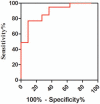Lymphocyte hydrogen sulfide production predicts intravenous immunoglobulin resistance in children with Kawasaki disease: A preliminary, single-center, case-control study
- PMID: 30461609
- PMCID: PMC6392715
- DOI: 10.1097/MD.0000000000013069
Lymphocyte hydrogen sulfide production predicts intravenous immunoglobulin resistance in children with Kawasaki disease: A preliminary, single-center, case-control study
Abstract
The aim of the study was to identify whether lymphocyte hydrogen sulfide production is a potential biomarker to predict intravenous immunoglobulin (IVIG) resistance in children with Kawasaki disease (KD).This preliminary, single-center, case-control study conducted between June 2016 and March 2018 in Shaanxi Provincial People's Hospital, 85 children (50 with KD and 35 healthy controls) were included. Laboratory biomarkers were collected from the medical records. All patients with KD received 1 g/kg/d IVIG for 2 days and 30-50 mg/kg/d oral aspirin. The aspirin dose was reduced from 3 to 5 mg/kg/d after body temperature normalized. Plasma hydrogen sulfide levels were detected using sulfide electrode. Lymphocyte hydrogen sulfide levels were detected using the human hydrogen sulfide ELISA kits at the acute stage.Of 50 patients with KD, 31 and 19 were diagnosed with complete KD (cKD) and incomplete KD (iKD), respectively. Eleven patients with KD were resistant to IVIG treatment. The laboratory biomarker findings and levels of plasma and lymphocyte hydrogen sulfide were significantly different between the patients with KD and control group (P < .001). Moreover, lymphocyte hydrogen sulfide production was significantly greater in IVIG-resistant patients than in the IVIG-responsive patients, both in cKD and iKD (P = .018 and P < .001 respectively). Receiver operating characteristic curve indicated that when the lymphocyte hydrogen sulfide production was >15.285 nmol/min/10 lymphocytes, the sensitivity and specificity for predicting IVIG resistance were 90.9% and 76.9%, respectively.Lymphocyte hydrogen sulfide production could serve as a predictor of the therapeutic efficacy of IVIG in children with KD.
Conflict of interest statement
The authors have no conflicts of interest to disclose.
Figures

Similar articles
-
Lymphocyte Hydrogen Sulfide Production Predicts Coronary Artery Lesions in Children with Kawasaki Disease: A Preliminary, Single-Center Study.J Trop Pediatr. 2020 Apr 1;66(2):171-177. doi: 10.1093/tropej/fmz047. J Trop Pediatr. 2020. PMID: 31302704 Free PMC article.
-
High-Dose Aspirin is Associated with Anemia and Does Not Confer Benefit to Disease Outcomes in Kawasaki Disease.PLoS One. 2015 Dec 10;10(12):e0144603. doi: 10.1371/journal.pone.0144603. eCollection 2015. PLoS One. 2015. PMID: 26658843 Free PMC article.
-
Kawasaki disease in Turkish children: a single center experience with emphasis on intravenous immunoglobulin resistance and giant coronary aneurysms.Turk J Pediatr. 2019;61(5):648-656. doi: 10.24953/turkjped.2019.05.002. Turk J Pediatr. 2019. PMID: 32104995
-
Recent advances in the treatment of Kawasaki disease.J Chin Med Assoc. 2011 Nov;74(11):481-4. doi: 10.1016/j.jcma.2011.09.001. Epub 2011 Nov 4. J Chin Med Assoc. 2011. PMID: 22100015 Review.
-
Kawasaki disease: a comprehensive review of treatment options.J Clin Pharm Ther. 2015 Dec;40(6):620-5. doi: 10.1111/jcpt.12334. Epub 2015 Nov 7. J Clin Pharm Ther. 2015. PMID: 26547265 Review.
Cited by
-
Gut microbiota and neuroinflammation in pathogenesis of hypertension: A potential role for hydrogen sulfide.Pharmacol Res. 2020 Mar;153:104677. doi: 10.1016/j.phrs.2020.104677. Epub 2020 Feb 2. Pharmacol Res. 2020. PMID: 32023431 Free PMC article. Review.
-
Lymphocyte Hydrogen Sulfide Production Predicts Coronary Artery Lesions in Children with Kawasaki Disease: A Preliminary, Single-Center Study.J Trop Pediatr. 2020 Apr 1;66(2):171-177. doi: 10.1093/tropej/fmz047. J Trop Pediatr. 2020. PMID: 31302704 Free PMC article.
References
-
- Kawasaki T, Kosaki F, Okawa S, et al. A new infantile acute febrile mucocutaneus lymph node syndrome (MLNS) prevailing in Japan. Pediatrics 1974;54:271–6. - PubMed
-
- Newburger JW, Takahashi M, Beiser AS, et al. A single intravenous infusion of gamma globulin as compared with four infusions in the treatment of acute Kawasaki syndrome. N Engl J Med 1991;324:1633–9. - PubMed
-
- Wallace CA, French JW, Kahn SJ, et al. Initial intravenous gammaglobulin treatment failure in Kawasaki disease. Pediatrics 2000;105:E78. - PubMed
-
- Sun Y, Yuan Y, Yan H, et al. Plasma hydrogen sulfide predicts coronary artery lesions in children with Kawasaki disease. Pediatr Int 2015;57:840–4. - PubMed
-
- Newburger JW, Takahashi M, Gerber MA, et al. Diagnosis, treatment, and long-term management of Kawasaki disease: a statement for health professionals from the Committee on Rheumatic Fever, Endocarditis and Kawasaki Disease, Council on Cardiovascular Disease in the Young, American Heart Association. Circulation 2004;110:2747–71. - PubMed
Publication types
MeSH terms
Substances
LinkOut - more resources
Full Text Sources
Medical

